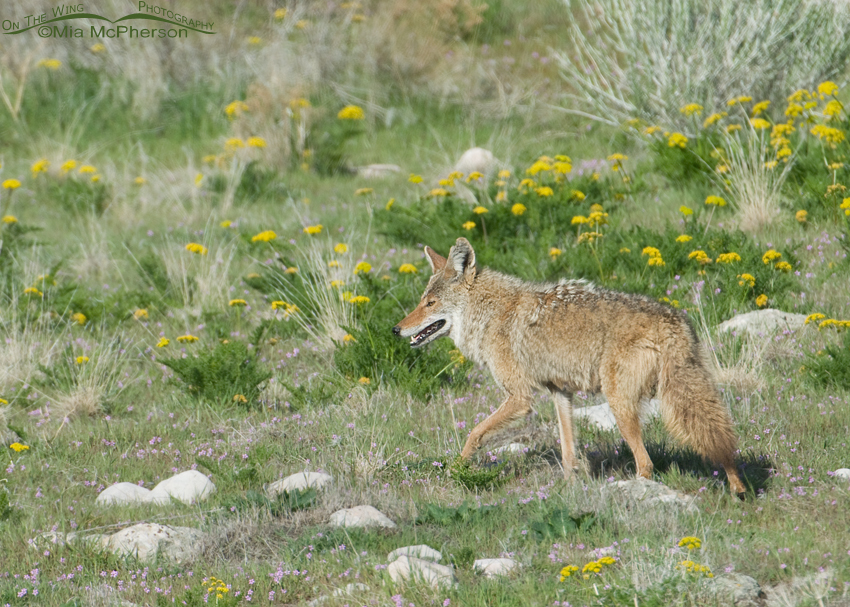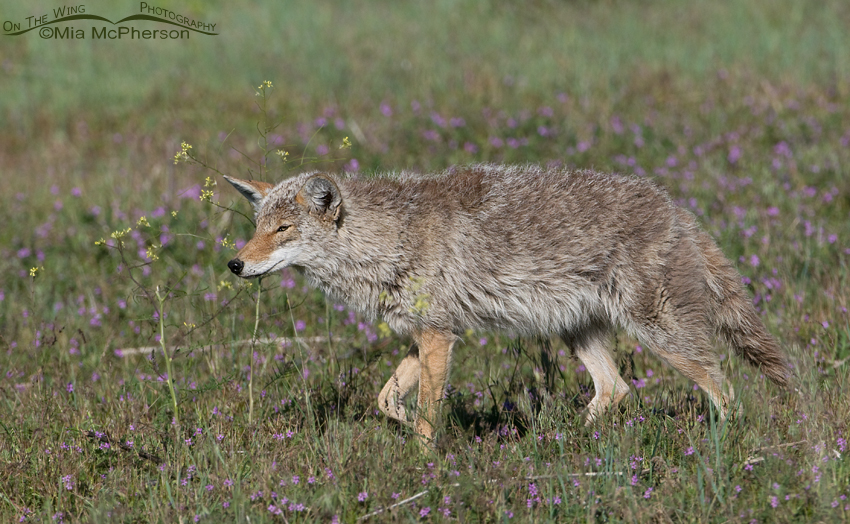Wildflowers and Coyotes
 Coyote surrounded by Gray’s Biscuitroot – Nikon D200, f7.1, 1/1000, ISO 320, +0.3 EV, Nikkor 200-400mm VR with 1.4x TC at 400mm, natural light, not baited or called in
Coyote surrounded by Gray’s Biscuitroot – Nikon D200, f7.1, 1/1000, ISO 320, +0.3 EV, Nikkor 200-400mm VR with 1.4x TC at 400mm, natural light, not baited or called in
On my last visit to Antelope Island State Park five days ago I noticed that some of the wildflowers have started to bloom including Gray’s Biscuitroot and Redstem Filaree. Gray’s Biscuitroot (Lomatium grayi) is a perennial herb that was used as a food source by Native Americans, the new stems were eaten raw and the tap root was used as a starvation food in the winter when little else was available. Gray’s Biscuitroot greens up very early in spring and has been identified as an important plant in Sage-Grouse habitat because the associated insects provide a critical food source for Sage-Grouse chicks.
The Coyote in my image above was hunting in a field on Antelope Island State Park in April of 2010 while the Gray’s Biscuitroot was in full bloom. The tiny pink flowers are Redstem Filaree (Erodium cicutarium) which is a herbaceous annual that was introduced to North American in the 18th century. The entire plant is edible and tastes like parsley when it is picked young.
 Coyote hunting in a field with Filaree and Black Mustard – Nikon D300, f6.3, 1/2000, ISO 500, -0.3 EV, Nikkor 200-400mm VR with 1.4x TC at 285mm, natural light, not baited or called in
Coyote hunting in a field with Filaree and Black Mustard – Nikon D300, f6.3, 1/2000, ISO 500, -0.3 EV, Nikkor 200-400mm VR with 1.4x TC at 285mm, natural light, not baited or called in
Black Mustard (Brassica nigra) is also among the spring wildflowers that bloom on the Island, they are the small yellow wildflowers above and in front of this Coyote’s face. They are much taller than the diminutive Filaree and Gray’s Biscuitroot and Black Mustard is edible too. The seeds can be used to make Mustard and the greens can be eaten. In some areas on the island the Black Mustard can be seen in thicker stands than in my Coyote image above.
I enjoy capturing images of Coyotes hunting on the island with wildflowers in the frame. The wildflowers add a splash of color and softness but I know that both the Coyotes and these wildflowers survive in a climate that could be considered harsh.
Spring is definitely awakening in the Great Basin.
Mia
To view more of my Coyote photos plus facts and information about this species click here.


Beautiful survivors. Beautiful, hardy survivors.
Wonderful pictures…love the expressions on the coyote’s face…and eho can resist something called “red stem Filaree”! Very interesting information about the edible plants, too….all new to me, though I’ve always been interested in native plants used for food and medicine.
Wonderful and Calming
You are so lucky, to have an animals like this, ours is the Fox. Gorgeous photos of CoyoteMia.
I can’t say enough good things about your coyote photos – I can never get within a country mile of one of those critters up here.